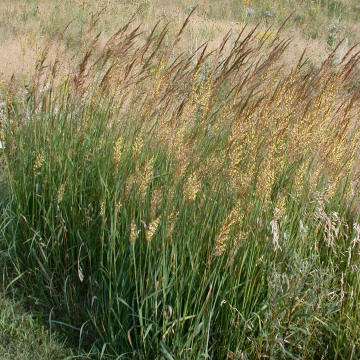

Sorghastrum nutans - (image 1 of 3)
Taxonomy
Family: Poaceae
Habitat
Common in moist or dry prairies. Also occurs in sandy oak savanna, open woods, and fields.
Associates
In prairies with Allium cernuum, Andropogon gerardii, Andropogon scoparius, Anemone cylindrica, Aster ericoides, Aster laevis, Baptisa leucantha, Comandra umbellata, Coreopsis tripteris, Desmodium canadense, Dodecatheon meadia, Elymus canadensis, Eryngium yuccifolium, Euphorbia corollata, Lespedeza capitata, Liatris spicata, Monarda fistulosa, Oxypolis rigidior, Panicum oligosanthes scribnerianum, Panicum virgatum, Parthenium integrifolium, Petalstemum candidum, Phlox pilosa fulgida, Ratibida pinnata, Solidago rigida, Spartina pectinata, Stipa spartea. In oak savanna with Aster azureus, Aster linariifolius, Ceanothus americanus, Eragrostis spectabilis, Helianthemum canadense, Helianthus occidentalis, Koelaria cristata, Liatris spicata, Lithospermum croceum, Prunus virginiana, Quercus velutina, Rosa carolina, Smilacina stellata, Solidago nemoralis, Toxicodendron radicans.
Distribution
Throughout the eastern U.S. and west to UT and AZ.
Morphology
Perennial grass to 2.5 m, the culms from short rhizomes. Culms smooth, hairy at the nodes. Leaves broad; sheaths glabrous to hirsute, ligule well-developed, firm, continuous with the auricles; blades 5-10 mm wide. Flowers in slender panicles 10-30 cm long, rather open; spikelets in pairs, yellow-brown, the nodes and smaller branches more or less villous; spikelets lanceolate, to 6-8 mm long, the first glume pale brown; sterile pedicels densely villous; lemmas 2, small thin, the lower lemma empty, the upper fertile and ending in a bent, twisted awn; awn 9-15 mm, bent once.
Notes
Flowers early August to late September
Wetland indicator: Facultative Upland +
This is a common component of tall grass prairie seed mixtures. It sometimes becomes overly-dominant in prairie restorations. Also called "goldstem", the culms have a shiny golden appearance in late summer, most visible when the leaf sheath is pulled away from the culm.
References
Clark, G. Lynn and Richard W. Pohl. 1996. Agnes Chase's First Book of Grasses: the Structure of Grasses Explained for Beginners. Fourth ed.
Smithsonian Institution Press. Washington and London
Gleason, Henry A. and A. Cronquist. 1991. Manual of Vascular Plants of
Northeastern United States
and Adjacent Canada. Second Ed.
The New York Botanical Garden. Bronx, NY
Knobel, Edward. 1980. Field Guide to the Grasses, Sedges and Rushes of the
United States. 2nd Ed.
Dover Publications, Inc. New York NY
Swink, F. and G. Wilhelm. 1994. Plants of the Chicago Region.
Indiana Academy of Science. The Morton Arboretum. Lisle, Illinois.
|
Michael Hough © 2005 |